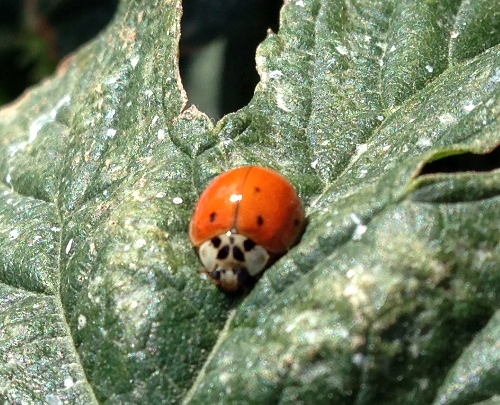Michigan hop update – Aug. 16, 2013
Hop cones are developing around Michigan with growers anticipating harvest in the coming weeks. Aphids are being spotted in higher numbers and should be carefully managed with cones present.
So far this season, the Benton Harbor Enviro-weather station has accumulated 1,911 GDD50 with 0.42 inches of rain over the past week; the Clarksville Enviro-weather station has recorded 1,717 GDD50 and 0.85 inches of rain this past week; and the Northwest Michigan Horticultural Research Center accumulated 1,603 GDD50 with 0.16 inches of rain over the last week.
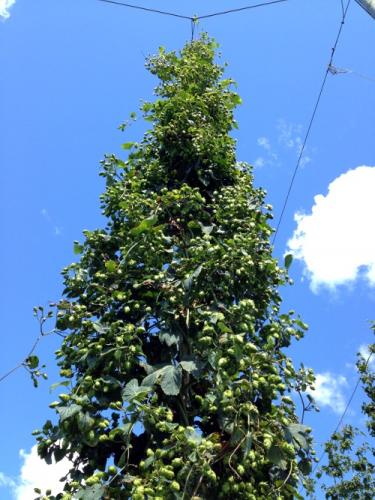
Hop development on Aug. 14, 2013 in northwest Michigan.
Photo credit: Erin Lizotte, MSU Extension
Downy mildew infections have been reigned-in for the most part, but growers should remain vigilant through harvest. Downy mildew is caused by Pseudoperonospora humuli and can cause significant yield and quality losses depending on variety and when infection becomes established. It is important that growers do not mistake downy mildew for powdery mildew (see photos below for clarification) as the effective pesticide classes are completely different. According to Michigan State University Extension, powdery mildew has not been confirmed in Michigan and is caused by Podosphaera macularis, a completely different pathogen than what causes downy mildew.
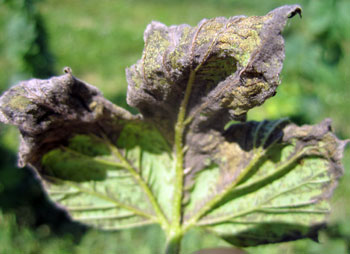
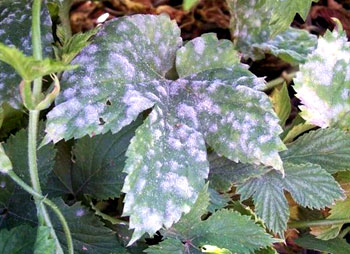
Left, The variety Centennial with downy mildew infections sporulating on the underside of the leaf.
Right, Powdery mildew on hop. Photo credits: (Left image) Erin Lizotte, MSU Extension, and (Right image) David Gent, USDA Agricultural Research Service, Bugwood.org
Fungicide applications should be made in response to environmental conditions that favor downy mildew. Fungicides containing copper, boscalid, pyraclostrobin, phosphorous acids and a number of biopesticides have varying activity against downy mildew (see Table 1 below). For organic growers, OMRI-approved copper formulations are the most effective. Be aware of preharvest intervals.
Table 1. Fungicides registered for hop production with activity against downy mildew
|
Activity |
Active ingredient (FRAC code) |
Product |
|
Broad spectrum |
Phosphorous acid, mono- and dibasic sodium, potassium, and ammonium salts(33) |
Phostrol |
|
Phosphorous acid, mono- and dipotassium salts(33) |
Confine Extra, K-Phite 7LP AG |
|
|
Basic Copper sulfate (M1) |
Cuprofix-Ultra 40 Disperss |
|
|
Copper diammonia diacetate complex |
Copper-Count-N |
|
|
Copper hydroxide(M1) |
Champ DP Dry Prill, Champ Formula 2 Flowable, Champ WG1, Kentan DF, Kocide 3000, Kocide-2000, NU-COP 3 L, NU-COP 50 DF1, NU-COP HB |
|
|
Copper hydroxide(M1); Copper oxychloride(M1) |
Badge SC, Badge X21 |
|
|
Copper octanoate(M1) |
Cueva1 |
|
|
Copper oxychloride sulfate(M1) |
C-O-C-S WDG |
|
|
Copper sulfate pentahydrate(M1) |
Mastercop |
|
|
Cuprous oxide(M1) |
Nordox 75 WG1 |
|
|
Single site-premix |
Boscalid(7); Pyraclostrobin(11) |
Pristine |
|
Biopesticides |
Bacillus pumilus strain QST 2808(44) |
Sonata1 |
|
Extract of Reynoutria sachalinensis(P5) |
Regalia1 |
|
|
Neem oil |
Trilogy1 |
1These product labels are OMRI-approved for organic production.
Adult Japanese beetle populations are ebbing for the season with less activity in southern Michigan. Adults continue to be reported in somewhat higher numbers as you head further north where they emerge later in the season due to slower temperature accumulation. Japanese beetle adults are a generalist pest and affect many crops found on or near grassy areas, particularly irrigated turf. Japanese beetle grubs feed on grass roots in early spring and again in the fall and can cause significant damage to turf. Larvae prefer moist soil conditions and do not survive prolonged periods of drought.
Adult Japanese beetles emerge in early July and feed on the top surface of leaves, skeletonizing the tissue. If populations are high, they can remove all of the green leaf material from a plant. Japanese beetle adults measure 0.375 to 0.5 inches long with a green thorax and copper-colored wing covers. There are five tufts of white hairs on both sides of the abdomen and a pair of tufts on the end of the abdomen that can help distinguish the Japanese beetle from other look-alike species. Visual observation of adults or feeding damage is an effective scouting technique. Because of their aggregating behavior, they tend to be found in larger groups and are typically relatively easy to spot.
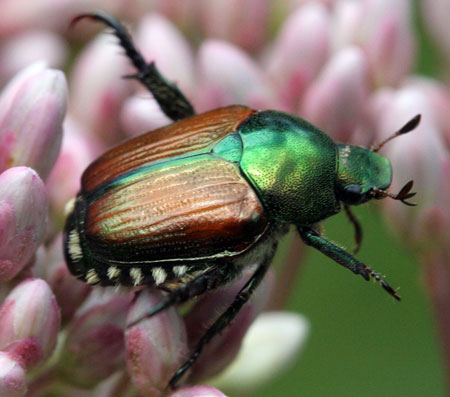
Adult Japanese beetle. Photo credit: David Cappaert, Michigan State University, Bugwood.org
There are no established treatment thresholds or data on how much Japanese beetle damage a hop plant can sustain, but growers should consider that well-established and vigorous bines will likely not require 100 percent protection. If treatment is necessary, growers will find a number of products labeled for Japanese beetles (Table 2). Organophosphates take longer to take effect (up to three days), but provide 10 to 14 days of residual control. Pyrethroids have good knockdown activity and seven to 10 days of residual control, but can be a concern in hopyards where mites are a problem. Pyrethroid use has been shown to flare mite populations as a result of its toxicity to beneficial predatory mites. Neonicitinoids act initially as a contact poison for two to five days, and then have a longer residual period of plant protection during which they have anti-feedant effects on adult beetles.
OMRI-approved organic options include neem-based products (azadirachtin) which have a one- to two-day residual and good knockdown activity, as well as Surround (kaolin clay) which has had good results in blueberries and grapes and acts as a physical barrier and irritant. Be aware of pre-harvest intervals.
Table 2. Insecticides labeled for hop production with activity against Japanese beetles, 2013
|
Chemical class (IRAC#) |
Active ingredient |
Label names |
|
Biopesticide |
Kaolin |
Surround-WP2 |
|
IGR+Pyrethroids(3A) |
Azadirachtin; Pyrethrins |
Azera |
|
Insect growth regulator or inhibitor |
Azadirachtin |
Aza-Direct2, Azatin XL, Ecozin Plus 1.2% ME2 |
|
Neonicotinoid(4A) |
Imidacloprid |
Admire Pro, Advise 2 FL, Alias 2F, Amtide Imidacloprid 2F, Couraze 2F Insecticide, Couraze 4F, Macho 2.0 FL, Macho 4.0, Malice 75 WSP Insecticide, Mana Alais 4F, Midash 2SC AG, Midash Forte, Montana 2F, Montana 4F, Nuprid 1.6 F, Nuprid 2F, Nuprid 2SC, Nuprid 4.6F PRO, Pasada 1.6 F, Pasada 1.6F, Prey 1.6, Provado 1.6 F, Sherpa, Widow, Wrangler |
|
Thiamethoxam |
Platinum, Platinum 75 SG |
|
|
Organophsophate(1B) |
Malathion |
Cheminova Malathion 57%, Malathion 5, Malathion 57 EC, Malathion 5EC, Malathion 8 Aquamul, Malathion 8 Flowable |
|
Pyrethroids(3A) |
Beta-cyfluthrin1 |
Baythroid XL |
|
Bifenthrin1 |
Bifen 2 AG Gold, Bifenture 10DF, Bifenture EC, Brigade 2EC, Brigade WSB Insecticide, Discipline 2EC, Fanfare 2EC, Fanfare ES, Sniper Tailgunner, Tundra EC |
|
|
Cyfluthrin1 |
Renounce 20WP, Tombstone, Tombstone Helios |
|
|
Pyrethrins |
Pyganic EC 1.4 II2, Pyganic EC 5.0 II2 |
|
|
Pyrethroids(3A) + Neonicotinoids(4A) |
Beta-cyfluthrin1; Imidacloprid |
Leverage 360 |
|
Bifenthrin1; Imidacloprid |
Brigadier |
|
|
Bifenthrin1; Imidacloprid |
Swagger |
|
|
Cyfluthrin1; Imidacloprid |
Leverage 2.7 Insecticide |
|
|
Unclassified + Pyrethroids(3A) |
Piperonyl butoxide; Pyrethrins |
Evergreen EC 60-6 |
1Products containing these active ingredients are classified as a restricted use pesticide and require the applicator to retain a pesticide applicator license.
2These product labels are OMRI-approved for organic production.
Growers should continue to monitor their hops for potato leafhopper populations. Potato leafhoppers move in all directions when disturbed, unlike some leafhoppers that have a distinct pattern of movement. Right now the adults and nymphs appear a fluorescent green color. Some very small nymphs are actually clear but have the characteristic shape of the larger nymphs when viewed using a hand lens.
Although hop plants are susceptible to potato leafhoppers, they can tolerate some level of feeding and growers should be conservative in the application of insecticides. Potato leafhoppers causes what growers have termed “hopper burn,” which causes necrosis of the leaf margin in a v-shaped pattern and may cause a yellowed or stunted appearance as well. The easiest way to observe potato leafhoppers is by flipping the shoots or leaves over and looking for adults and nymphs on the underside of leaves.
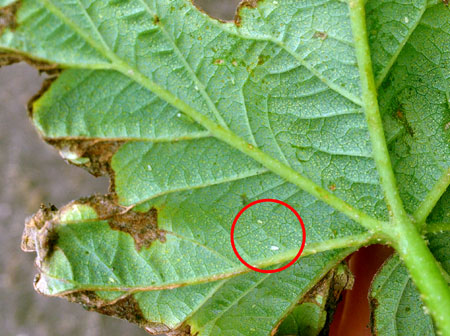
Multiple nymph stages of potato leafhopper and the associated
hopper burn symptoms around the leaf margin. Note that
leafhoppers can be very small and clear at some leaf stages.
Photo credit: Erin Lizotte, MSU Extension
Growers needing to treat for potato leafhoppers can utilize products containing neonicitinoids, pyrethroids, organophosphates or spinosyns. Organic growers can utilize Entrust (spinosad) or Pyganic (pyrethrin) formulations that are OMRI-approved for potato leafhopper management.
As temperatures rise and the weather dries out in the coming days, growers should remain vigilant in scouting for two-spotted spider mites with populations currently relatively low, likely due in part to the cool wet weather. Two-spotted spider mites are a significant pest of hops in Michigan and can cause complete economic crop loss when high numbers occur by decreasing the photosynthetic ability of the leaves and causing direct mechanical damage to the hop cones.
Two-spotted spider mites feed on the liquid in plant cells eventually causing visible symptoms. Leaves take on a white appearance and will eventually defoliate under high pressure conditions. Intense infestations weaken the plant and reduce yield and quality. Infested cones develop a reddish discoloration, do not hold up to the drying process, and commonly have lower alpha levels and shorter storage potential. Additionally, the mites themselves act as a contaminate issue for brewers.
Two-spotted spider mites thrive under hot conditions with the pace of development increasing until an upper threshold around 100 degrees Fahrenheit is reached. Conversely, cold and wet weather is not conducive to development. Two-spotted spider mites are very small, but can be observed on the underside of leaves using a hand lens. The eggs look like tiny, clear spheres and are most commonly found in close proximity to adults and larvae. The larvae themselves are small, translucent versions of the adults which begin the season with a distinctly orange hue that changes over to translucent, yellow or green as they feed. Adults also have two dark spots. When you are observing the underside of leaves, keep an eye out for beneficial, predatory mites that actually feed on two-spotted spider mites. Predatory mites are often translucent, larger than two-spotted spider mites and move at a much faster speed across the leaf surface. Predatory mites play an important role in balancing the two-spotted spider mite population and should be protected when possible.
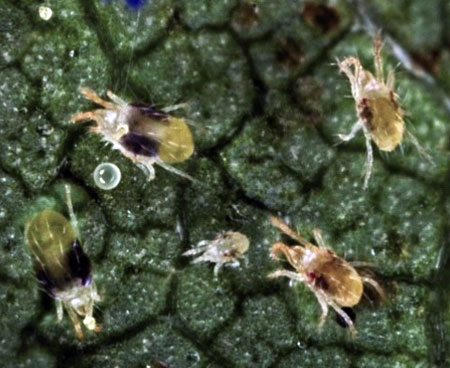
Adult two-spotted spider mites, nymphs (immatures) and eggs.
Photo credit: David Cappaert, MSU
Growers should be scouting for mites now and remember that only when mites reach an economically significant level should cultural and chemical intervention be considered. Use a hand lens to evaluate two leaves from 20 plants per yard. Thresholds developed in the Pacific Northwest have established that more than two adult mites per leaf in June indicate the need to implement a pest management strategy. By mid-July, the threshold increases to five to 10 mites per leaf. Remember that if cones are not infested, hop plants can tolerate a good deal of damage from mites.
Damson hop aphids are being observed in higher numbers, in some cases approaching the eight to 10 per leaf threshold established in the eastern United States. Hop aphids can reduce plant productivity and excrete “honeydew” which makes an excellent growth medium for sooty mold and can greatly reduce the quality and salability of a crop. According to “Compendium of Hop Diseases and Pests,” under heavy infestations defoliation can occur and later in the season aphids can feed within cones and can cause economic damage to the crop even at low levels. Symptoms of hop aphid feeding include leaf cupping and the appearance of honeydew (a sugary frass) and the associated black sooty mold.
Hop aphids overwinter as eggs on Prunus species. In early spring, eggs hatch into stem mothers that give birth to wingless females that feed on the Prunus host. In May, winged females are produced and travel to hop plants where additional generations of wingless females are produced. As cold weather approaches, winged females and males are produced, move back onto a Prunus host, mate and lay eggs for before winter.
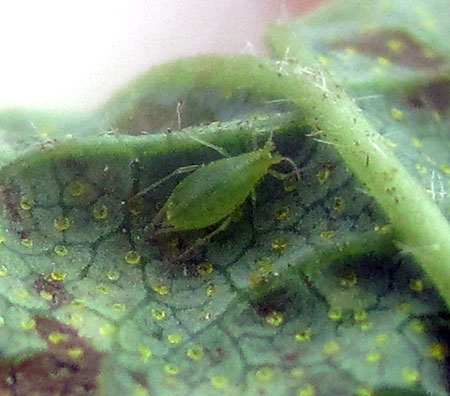
Wingless hop aphid on the underside of a hop leaf.
Photo credit: Erin Lizotte, MSU Extension
Hop aphids can be found on the upper and lower surface of the leaves. Currently, we are observing nymphs primarily on the underside and unwinged adults on the upper and lower leaf surface. In some seasons, control before the flowering stage may be important to protect crop quality when populations are high. Insecticides containing neem (some of which are organic), neonicitinoids (including products containing imidacloprid or thiamethoxam), flonicamid (labeled as Beleaf) or spirotetramat (labeled as Movento) all have activity against hop aphid.
A number of beneficial insects were also spotted this week including ladybugs and lacewing eggs.



 Print
Print Email
Email